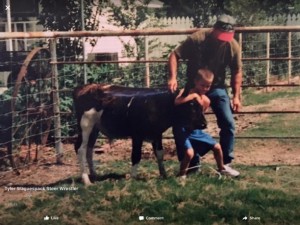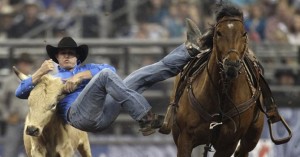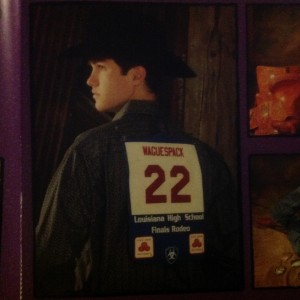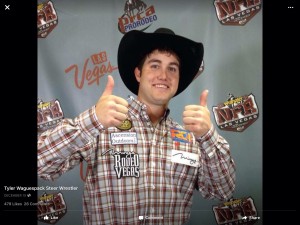By Mike Milazzo and Barbara Newtown.
 Tyler Waguespack of Gonzales, Louisiana, knows that success in professional steer wrestling comes from physical and mental preparation, great horses, and great teachers.
Tyler Waguespack of Gonzales, Louisiana, knows that success in professional steer wrestling comes from physical and mental preparation, great horses, and great teachers.
Tyler’s first mentor was his dad, Mike, who rodeo’d in the Southeastern circuit in the 1990s. Tyler remembers playing in the dirt at rodeos and watching his dad ride. For a while baseball competed with rodeo for Tyler’s attention, but, as he says, “I got to liking rodeo more, and I put up the baseball glove.”
Mike taught Tyler the importance of hard work. He said that if he had to get up at 5 AM to go earn a living, Tyler had to get up as well and do barn chores before school. “And then as soon as school was out, I’d head back home, saddle up the horses, work the arena, pen the steers, and get everything ready. When Dad got home, he would walk straight to the pen and we would practice all afternoon,” says Tyler.
 By the time Tyler was in high school, a typical afternoon practice at home would involve chute dogging about 50 steers and throwing another 15 or 20 steers from horseback. “By that time,” he says, “I was a good enough hand on a horse that I could train horses, too.”
By the time Tyler was in high school, a typical afternoon practice at home would involve chute dogging about 50 steers and throwing another 15 or 20 steers from horseback. “By that time,” he says, “I was a good enough hand on a horse that I could train horses, too.”
Rodeo experts around Gonzales played a big part in Tyler’s training. When he was 10 years old, Tyler started calf roping under Arthur Smith’s guidance. A typical session at Smith’s facility started with flanking and tying calves and progressed to roping 7 or 8 calves, letting the horses rest a while, and then roping a few more. By the end of high school Tyler was practicing roping at Troy Aucoin’s house, in nearby French Settlement, Louisiana. “We worked 15 or 20 calves every time we went, and we would flank and tie each one of them about 3 or 4 times, as long as they were still feeling good,” Tyler says.
 Tyler didn’t make it to the National High School Finals Rodeo when he was a freshman. “I would catch about every steer and I never could stop them. I weighed probably 110 to 115 pounds that year. I was a little light in the shorts!” By sophomore year he had gained some weight and refined his techniques, and the hard practice paid off. He made the trip to the National Finals that year and the next two years as well. “Sophomore year, 2008, I ended up winning the state in steer wrestling and doing well in calf roping. In 2009 I won state in steer wrestling again. Senior year I won state in steer wrestling and qualified for the national finals in calf roping.” Tyler says that he asked his dad if he could ride a different bull dogging horse in each go round at the state competition in 2010. He set himself a personal challenge: could he win the average on three different horses that he had trained throughout high school? The answer: yes!
Tyler didn’t make it to the National High School Finals Rodeo when he was a freshman. “I would catch about every steer and I never could stop them. I weighed probably 110 to 115 pounds that year. I was a little light in the shorts!” By sophomore year he had gained some weight and refined his techniques, and the hard practice paid off. He made the trip to the National Finals that year and the next two years as well. “Sophomore year, 2008, I ended up winning the state in steer wrestling and doing well in calf roping. In 2009 I won state in steer wrestling again. Senior year I won state in steer wrestling and qualified for the national finals in calf roping.” Tyler says that he asked his dad if he could ride a different bull dogging horse in each go round at the state competition in 2010. He set himself a personal challenge: could he win the average on three different horses that he had trained throughout high school? The answer: yes!
Tyler admits that he never had much success at the National High School Finals. In fact, his sophomore year a steer actually flipped his horse. “The year after that, 2009, I didn’t have much luck. In 2010 I made a good run on my first steer, and on my second steer I knocked him down and couldn’t get him back up.” But just the week before those disappointing High School Finals, Tyler won the steer wrestling at the International Finals Youth Rodeo in Shawnee, Oklahoma.
 Tyler made the decision after he graduated from high school that he wanted to concentrate on steer wrestling. “I had a pretty nice calf horse. I could sell him and get another bull dogging horse, or I could keep trying to do both. I was having a lot of success in steer wrestling and that was what I really wanted to do…so I sold the calf horse and got another bull dogging horse.”
Tyler made the decision after he graduated from high school that he wanted to concentrate on steer wrestling. “I had a pretty nice calf horse. I could sell him and get another bull dogging horse, or I could keep trying to do both. I was having a lot of success in steer wrestling and that was what I really wanted to do…so I sold the calf horse and got another bull dogging horse.”
In 2011 Tyler competed in the Louisiana Rodeo Association and the Tristate Rodeo Association and won both year-end titles in steer wrestling. In 2012 he bought his Professional Rodeo Cowboys Association card and “went out on the big road,” putting over 60,000 miles on his truck. He ended up just outside the top 50 in 2012. “It was a big, big difference from being a big fish in a little pond down here to being a small fish in the big ocean out there,” he says.
2013 started off with a bang. Tyler was in the top 10 in the world by April and qualified for the Houston rodeo, where he ended up in the top 4. His good fortune didn’t hold, though. At the RAM National Circuit Finals Rodeo he was chute dogging steers to get them ready for the competition, and, he says, “a steer stopped with me and tore my pec!” Tyler had to come home and recuperate until the summer of 2013 was half over. “Then I loaded up with a good buddy of mine, Daryl Petri from Texas, and he helped me finish the year out,” says Tyler. Despite missing almost half a year of rodeoing, he and Daryl ended up finishing just outside the top 30 in the PRCA.
In 2014 Tyler “got in the rig” with Ote Berry from Oklahoma, a four-time PRCA champion. “I moved up to his house and practiced with him every day. I rodeo’d with him and rode his horses all year long and ended just outside the top 15, missing the finals by 3 or 4 thousand dollars.” Riding Ote’s horses was part of the deal. However, as the 2015 season started, Tyler was impressed with how his own horse was going, and he wanted to ride him in competition. He decided to go out on his own. He traveled with Tyler Pearson, Kyle Irwin, Rowdy Parrot and Orin Fontenot. “I got to ride my own horse, a palomino named Outlaw, and a sorrel named Sketch that Tyler Pearson had. Kyle and I made the national finals and Tyler Pearson just missed it by a couple thousand bucks.”
Tyler knew he’d made the cut for the 2015 National Finals Rodeo as of October 1st. He stood in 7th place and had won $75,000 in the run-up to the competition. He put the next three months to good use practicing specifically for the conditions he knew he’d face at the Thomas and Mack Center in Las Vegas. “The arena is small and the start is really, really fast. You have to have your horse moving off of the corner of the box before the gates open. It’s kind of a weird feeling, because you are running at a barrier,” he says. “It’s hard to make yourself ride, hoping that the gate is going to open!”
Tyler worked on his starts at home in Gonzales. Then, three weeks before the Finals, he, Kyle, and Tyler Pearson loaded up and hauled to California to practice with five-time world champion steer wrestler Luke Branquinho. “The stock contractors were able to get the steers that would be at the Finals over to Luke’s house for any contestant to practice on. We were able to prepare ourselves.” Tyler says that it was a great help being coached by Luke and Trevor Knowles and other experienced hands who had competed in the past in the Thomas and Mack Center.
Despite all his preparation, Tyler was still nervous when the Finals started. He says, “You ride down that alley way in the grand entrance and every contestant is on horseback… The top 15 contestants in the world standings in every event are all in one arena. It’s really, really nerve-wracking.”
Like all sports that involve animals, a lot depends on luck. In the first round, Tyler missed the barrier but made a decent run just out of the money. “That got the ice broke,” he says. “After that I drew just okay steers. I made decent runs on them, but never really anything to get deep into the money. By round 5 I finally had a pretty good steer, one that they had placed on earlier in the week. I was 4.1 on him.” Tyler luck had turned around. In round 7 he was 3.2, which not only won him the round, but ended up being the fastest time in the finals. Tyler placed 6th in the average, with one win and two more placings.
Tyler rode the sorrel Sketch in the Finals. Sketch is unregistered and, according to Tyler, has a couple of screws loose. But Kyle Irwin had ridden Sketch in the 2014 Finals and Sketch was used to the Thomas and Mack Center. “Sometimes you back him into the box and he can feel you get nervous and then he gets nervous, but that’s on us. He’s trained to go as hard as he can whenever we tell him to. You can’t complain about how he works. He did great out there,” Tyler says.
Tyler says that the atmosphere at the Finals is supportive: the competitors joke around and tease each other, even though they’re doing all they can to come out on top. “Everybody is pulling for everybody—slapping each other on the back, high-fiving, wishing each other good luck. When someone has a good run, everybody is congratulating them, and if someone makes a bad run, you have 14 guys there to help him pick his head up.”
Tyler has advice for young competitors. “You can’t just expect it to happen. You have to go out and put in the hours and the hard work and make it happen. As far as bull dogging goes, I was too small to compete, but my dad and I talked about it… If I bore down and worked at it and got better in every way but the size, then it would leverage itself out.” On a level playing field, a steer should always win. But successful bull doggers know that horse sense, cow sense, technique sense, and the good sense of a good teacher can give humans the advantage.





